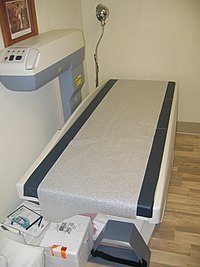
Photo from wikipedia
INTRODUCTION Osteopetrosis is a connective tissue disorder resulting from abnormally dense bone predisposing patients to fracture. The clinical pattern of fractures across time and space as well as suggestive radiographic… Click to show full abstract
INTRODUCTION Osteopetrosis is a connective tissue disorder resulting from abnormally dense bone predisposing patients to fracture. The clinical pattern of fractures across time and space as well as suggestive radiographic findings usually raises diagnostic suspicion. Multiple genetic mutations resulting in dysfunctional osteoclasts have been implicated in the pathogenesis of osteopetrosis with variable inheritance patterns. In severe cases, usually inherited in an autosomal recessive pattern, the medullary cavity important in the production of normal blood cell progenitors is replaced by defective endochondral bone, leading to pancytopenia and consequential extramedullary hematopoiesis. MATERIALS AND METHODS This is a case report from a patient presenting to Naval Medical Center San Diego, a large Military Treatment Facility constituting a regional referral center for Navy Medicine West and serving approximately 250,000 eligible patients with more than 6,200 military and civilian staff. The genetic analysis was performed by Connective Tissue Gene Tests (CTGT) using the CTGT Osteopetrosis NextGen sequencing panel, consisting of 13 genes associated with osteopetrosis. A literature review was performed using PUBMED and Google Scholar to identify information on osteopetrosis and mutation implications. RESULTS We present a 19-year-old male with clinical osteopetrosis resulting from compound heterozygosity of several mutated alleles within the PLEKHM1 gene, which is important to endosomal and lysosomal vesicular function. To date, most mutations discovered involve genes coding for intracellular enzymes, like carbonic anhydrase, or cell surface transporters, such as the osteoclast H+-ATPase proton pump and the chloride channel, engaged in the acidification of bone at the interface of the osteoclastic ruffled border and the bone matrix. This case represents one of the few reports of inherited defects within the PLEKHM1 gene, resulting in defective osteoclastic ruffled border formation and consequential inadequate bone resorption. CONCLUSIONS This patient's lack of hematologic deficiencies and survival into adulthood portend an improved long-term prognosis and may infer prognostic insight in future cases with similar genetic abnormalities. In patients presenting with skeletal abnormalities and pathologic fractures in early adulthood, the clinician should consider osteopetrosis as a potential explanatory mechanism. Genetic characterization can elucidate cellular pathophysiology and potentially guide treatment modalities. Patients are typically managed with lifestyle adjustments limiting traumatic fracture and antiresorptive medications, typified by the bisphosphonate class. Since osteoclasts derive from a hematopoietic precursor, the only definitive curative therapy present is hematopoietic stem cell transplant. In the future, novel genomic level modulation may confer the ability to correct underlying point mutations and spare individuals from the morbidity associated with bone marrow transplant.
Journal Title: Military medicine
Year Published: 2017
Link to full text (if available)
Share on Social Media: Sign Up to like & get
recommendations!